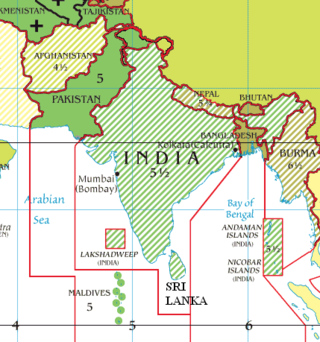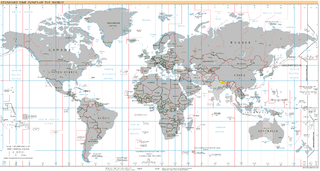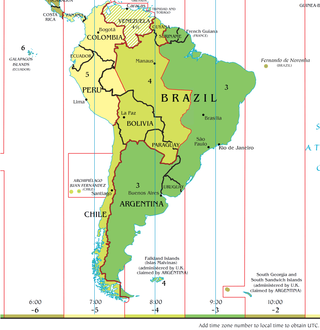
A time zone is an area which observes a uniform standard time for legal, commercial and social purposes. Time zones tend to follow the boundaries between countries and their subdivisions instead of strictly following longitude, because it is convenient for areas in frequent communication to keep the same time.
In communications messages, a date-time group (DTG) is a set of characters, usually in a prescribed format, used to express the year, the month, the day of the month, the hour of the day, the minute of the hour, and the time zone, if different from Coordinated Universal Time (UTC). The order in which these elements are presented may vary. The DTG is usually placed in the header of the message. One example is "06:59 Apr 05, 2024 (UTC)"; while another example is "06:59 05 Apr 2024".

Indian Standard Time (IST), sometimes also called India Standard Time, is the time zone observed throughout the Republic of India, with a time offset of UTC+05:30. India does not observe daylight saving time or other seasonal adjustments. In military and aviation time, IST is designated E* ("Echo-Star"). It is indicated as Asia/Kolkata in the IANA time zone database.

The Pacific Time Zone (PT) is a time zone encompassing parts of western Canada, the western United States, and western Mexico. Places in this zone observe standard time by subtracting eight hours from Coordinated Universal Time (UTC−08:00). During daylight saving time, a time offset of UTC−07:00 is used.

The Hawaii–Aleutian Time Zone observes Hawaii–Aleutian Standard Time (HST) by subtracting ten hours from Coordinated Universal Time (UTC−10:00). The clock time in this zone is based on the mean solar time of the 150th meridian west of the Greenwich Observatory.

UTC+08:00 is an identifier for a time offset from UTC of +08:00.

UTC+03:00 is an identifier for a time offset from UTC of +03:00. In areas using this time offset, the time is three hours later than the Coordinated Universal Time (UTC). Following the ISO 8601 standard, a time with this offset would be written as, for example, 2019-02-08T23:36:06+03:00.

Nepal Standard Time (NPT) is the time zone for Nepal. With a time offset from Coordinated Universal Time (UTC) of UTC+05:45 all over Nepal, it is one of only three time zones with a 45-minute offset from UTC.

South African Standard Time (SAST) is the time zone used by all of South Africa as well as Eswatini and Lesotho. The zone is two hours ahead of UTC (UTC+02:00) and is the same as Central Africa Time. Daylight saving time is not observed in either time zone. Solar noon in this time zone occurs at 30° E in SAST, effectively making Pietermaritzburg at the correct solar noon point, with Johannesburg and Pretoria slightly west at 28° E and Durban slightly east at 31° E. Thus, most of South Africa's population experience true solar noon at approximately 12:00 daily.

Australia uses three main time zones: Australian Eastern Standard Time, Australian Central Standard Time and Australian Western Standard Time.

The time in China follows a single standard time offset of UTC+08:00 based on the National Time Service Center of Chinese Academy of Sciences located in Mount Li, Lintong District, Xi'an City, Shaanxi Province, even though the country spans almost five geographical time zones. The official national standard time is called Beijing Time domestically because based on 120th meridian east that Beijing City is located, and China Standard Time (CST) internationally. Daylight saving time has not been observed since 1991. China Standard Time (UTC+8) is consistent across Mainland China, Hong Kong, Macau, Taiwan, as well as equivalent with Philippines, Singapore, Brunei, most of Mongolia, Malaysia, Irkutsk Time (Russia), Western Australia and Central Indonesia.

UTC+05:45 is an identifier for a time offset from UTC of +05:45. The time zone is used in Nepal. It is one of only three time zones with a 45-minute offset from UTC.
Time in Chile is divided into three time zones. Most of Continental Chile uses the time offset UTC−04:00 in winter time and UTC−03:00 in summer time, while the Magallanes and Chilean Antarctica region uses the time offset UTC−03:00 the whole year. Additionally, Easter Island uses the time offset UTC−06:00 in winter time and UTC−05:00 in summer time.

Argentina is located at a longitude that would naturally put it in the UTC−04:00 or UTC−05:00 time zone; however, it actually uses the UTC−03:00 time zone. Argentina determines whether to change clocks in observation of daylight saving time on a year-by-year basis, and individual provinces may opt out of the federal decision. At present, Argentina does not change clocks.
The UTC offset is the difference in hours and minutes between Coordinated Universal Time (UTC) and local solar time, at a particular place. This difference is expressed with respect to UTC and is generally shown in the format ±[hh]:[mm], ±[hh][mm], or ±[hh]. So if the time being described is two hours ahead of UTC, the UTC offset would be "+02:00", "+0200", or simply "+02".
Venezuela uses the UTC−04:00 time offset, and they had previously used UTC−04:30 from 9 December 2007 until 30 April 2016. The time is commonly called Venezuelan Standard Time (VET), and legally referred to as Hora Legal de Venezuela (HLV) or Venezuela's Legal Time. The HLV is administered by the Navigation and Hydrography Service, in the Cagigal Naval Observatory, Caracas.

Azerbaijan Time, abbreviated as AZT, is the standard time zone in Azerbaijan, four hours ahead of UTC (UTC+04:00). The daylight saving time adjustment, Azerbaijan Summer Time (AZST), was one hour ahead at UTC+05:00 and was introduced in 1997 and discontinued in March 2016.

National Standard Time is the official time zone in Taiwan defined by an UTC offset of +08:00. This standard is also known as Taipei Time (臺北時間), Taiwan Time (臺灣時間) or Taiwan Standard Time (TST).

In Turkey, time is given by UTC+03:00 year-round. This time is also called Turkey Time (TRT). The time at most is the same as in the Moscow Time and Arabia Standard Time zones. TRT was adopted by the Turkish Government on 8 September 2016. It was also in use in Northern Cyprus until it reverted to Eastern European Time (EET) in October 2017.
The 2016 Asia Rugby Championship division tournaments refers to the divisions played within the annual international rugby union tournament for the Asian region. The Asia Rugby Championship (ARC) replaced the Asian Five Nations tournament in 2015. The main tournament is now contested by the top three teams in Asia. The other national teams in Asia compete in three divisions.












